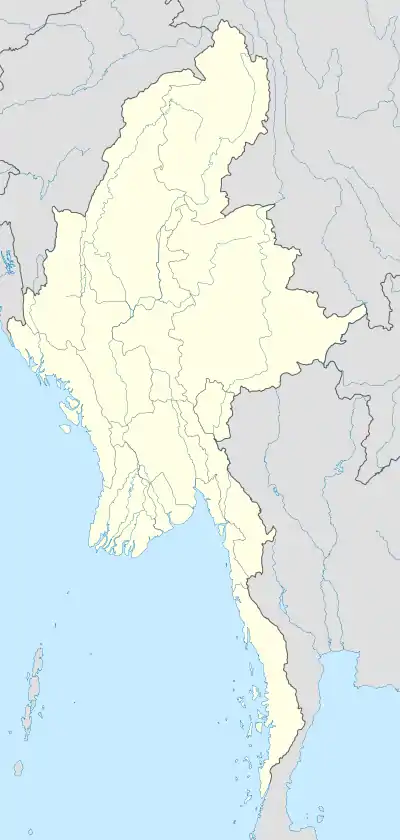| Uppātasanti Pagoda ဥပ္ပါတသန္တိစေတီတော် | |
|---|---|
 The pagoda from a distance | |
| Religion | |
| Affiliation | Buddhism |
| Sect | Theravada Buddhism |
| Location | |
| Location | Naypyidaw |
| Country | Myanmar |
 Shown within Myanmar | |
| Geographic coordinates | 19°46′16.14″N 96°10′58.76″E / 19.7711500°N 96.1829889°E |
| Architecture | |
| Founder | State Peace and Development Council |
| Completed | March 2009 |
Uppātasanti Pagoda (ဥပ္ပါတသန္တိစေတီတော်, pronounced [ʔoʊʔpàta̰ θàɰ̃dḭ zèdìdɔ̀]; officially called ဥပ္ပါတသန္တိစေတီတော်မြတ်ကြီး, also called the "Peace Pagoda") is a prominent landmark in Naypyidaw, the capital of Myanmar. The pagoda houses a Buddha tooth relic.[1] It is nearly a same-sized replica of Shwedagon Pagoda in Yangon and stands 99 metres (325 ft) tall.[2]
History
Construction of Uppatasanti Pagoda began on 12 November 2006, with the stake-driving ceremony, and completed in March 2009, built under the guidance of Than Shwe, head of Burma's ruling State Peace and Development Council.[2] The invitation card for the stake-driving ceremony opened with a phrase "Rājaṭhānī Naypyidaw" (the royal capital).[3] The pagoda is 30 centimetres (12 in) shorter than the Shwedagon Pagoda.[4] The name "Uppātasanti" roughly translates to "protection against calamity". It is the name of a sutta prepared by a monk in the early 16th century. It is to be recited in time of crisis, especially in the face of foreign invasion.[5]
On 4 March 2009, 20 people died during a ferris wheel accident at a festival marking the pagoda's consecration.[6] The consecration of the pagoda, which involves the hoisting of the htidaw (sacred umbrella, ထီးတော် [tʰí dɔ̀]) and the seinbudaw (diamond lotus bud, စိန်ဖူးတော် [sèɪɰ̃ bú dɔ̀]), took place on 10 March 2009.[1]
Structure
The massive base of the pagoda which may be mistaken for a large hill is completely man-made. The pagoda precinct also comprises:[2]
- Maha Hsutaungpyae Buddha Image in Maha Pasadabhumi Gandhakuṭi Chamber
- Four jade Buddha images in the pagoda's hollow cave
- 108 feet high tagundaing (flagstaff)
- Bo tree Garden with Maha Bo Tree and the images of the 28 Buddhas
- Garden of 108 Bo Trees
- Mālinī Maṅgala Lake with the chamber of Shin Upagutta
- Withongama Ordination Hall (thein)
- Cetiyapala Chamber
- Sangha Yama hostels
- Sasana Maha Beikmandaw Building
- Pagoda museum
- Pitakat Building and Religious Archive
Captive white elephants
Seven captive white elephants are kept at the pagoda grounds, under the custody of the Ministry of Natural Resources and Environmental Conservation's Forest Department.[7][8] They are kept in inhumane conditions, shackled for 22 hours a day and housed in small open-air pavilions.[9]
Gallery
 Plaza at sunset
Plaza at sunset
References
- 1 2 "Than Shwe's New Pagoda Hides More than a Buddha Relic". The Irrawaddy. March 10, 2009. Archived from the original on August 11, 2010. Retrieved December 10, 2015.
- 1 2 3 "Signs of rapid development in Nay Pyi Taw". MRTV-3.
- ↑ Steinberg, David (2009). Burma/Myanmar: What Everyone Needs to Know. Oxford University Press. p. 133. ISBN 978-0-19-539068-1.
- ↑ "Naypyidaw's Version of Shwedagon Pagoda Nears Completion". The Irrawaddy. March 6, 2009. Archived from the original on August 11, 2010. Retrieved January 6, 2010.
- ↑ Weekly Eleven News Journal. 1 (44): 9. 16 August 2006.
{{cite journal}}: Missing or empty|title=(help) - ↑ "20 Reported Dead in Naypyidaw Funfair Disaster". The Irrawaddy. 2009-03-10. Retrieved 2023-03-26.
- ↑ Hirschi, Eva (2019-01-19). "Improving life for Yangon's white elephants". Frontier Myanmar. Retrieved 2023-03-26.
- ↑ "Status-Obsessed Myanmar Junta Chief's Reverence for White Elephants Draws Ridicule". The Irrawaddy. 2022-08-04. Retrieved 2023-03-26.
- ↑ Hirschi, Eva (2019-01-19). "Improving life for Yangon's white elephants". Frontier Myanmar. Retrieved 2023-03-26.